Winter is not the most active time of a private pilot. Yet it brings at least one advantage: the hour change back to winter time between October and March.
With darkness coming early it is then possible to log night hours early in the evening.
If the right to fly at night is granted with the FAA PPL in the USA, it is not the case in Europe where it is an additional rating.
VFR pilots willing to fly at night will have to enrol in a night VFR course with an approved School. The requirements for the rating are:
- A ground course specific to night flying.
- 5 hours flight time in the appropriate aircraft category at night.
- Of which 3 of the above must be dual.
- Of which 1 of the above must be a navigation flight of at least 50km (27Nm)
- 5 Solo take-off and landings (Touch and goes)
- The above must be completed within 6 months.
- The ATO I chose added 1 hour of simulator to the above.
I inquired different schools to take my night rating. The first one was Skywings in Antwerp (EBAW) and New CAG in Charleroi (EBCI).
The initial contact I had with Skywings were rather cold and uninterested whereas the contact I had with New CAG was rather warm and friendly.
I thus decided to fly with New CAG and their Diamond DA-40.
The adventure started a Saturday morning at EBCI for the ground course.
We were all taught the specificities for night flying where airplane, airport and pilot must be adequately equipped for the night. After spending a lot of time with human factors (eyes, ears, spatial disorientation, …) we even had time to plan a cross country night flight we would all have to perform later in the training.
From the end of the briefing, the clock started ticking. We have 6 months to complete the training. I figured out I would book 2 flights per month allowing 50% of my flights to be scrapped due to weather as it is often the case in Belgium.
The first night flight:
My first two flights were booked in November 2022. As usual the first one didn’t look good: the day of the flight was a general strike day in Belgium and most of the commercial flights at EBCI were cancelled. Against my usual bad luck the airport remained open, the ATC was working and the fire rescue was not on strike. I felt like kissing all these guys: my flight was on and there would be no delay for traffic on this one.
We stepped around 19.30 local, the airport was totally silent and we had the impression the area was all for us.


This flight was first an orientation flight within the CTR (otherwise a flight plan would have been required) for my instructor to gauge if I had problems with the lack of visual horizon. The lack of horizon really did not bother me, beside the G1000 has a huge horizon line right in front of my nose if I lower my eyes a bit.
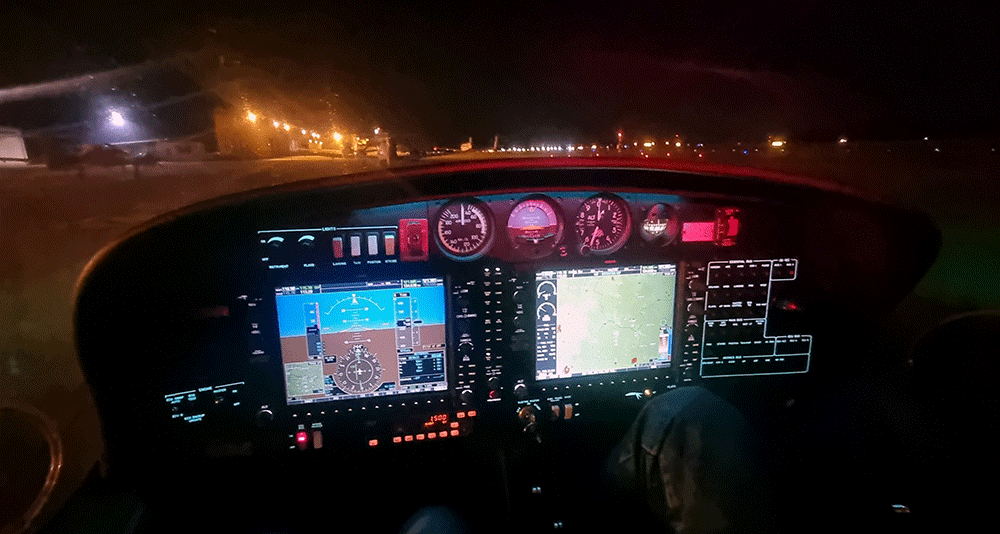
After the usual 360°, climb and descent and the unusual attitude recovery I had to perform, we came back to into the pattern for our first touch and goes.
The view when turning base when the runway lights slowly started to appear and the 3 whites and 1 red of the PAPI were a sight I will never forget. I felt really privileged to enjoy that view being at the control of an airplane.
I let that feeling go and focused with all my senses on my first night landing.
Tower cleared for touch and go and I switched the landing light on for the first time with a purpose other than being seen, but rather see. Well I was disappointed.
That Diamond landing light at the far end of the left wing is close to useless. It didn’t really help me see the runway. Luckily the moon was bright and I had no trouble seeing the runway to execute my flare. Another milestone in my amateur career.
The rest of the flight was intense with many touch and goes: flapless, without landing lights, without PAPI, … We finished in beauty with my first ILS. We extended downwind and setup the G1000 for an ILS 24 approach. I stayed inside focused on the instrument up to the minima at 200 feet AGL where the runway jumped at my nose for a full stop at 2157 local. Just 3 minutes before the 10PM local rules
What a flight. No one in the air. Almost 2 hours of flying at night for the first time !
The second night flight & the sim:
This one was scrapped for heavy fog. This time the commercials were flying … IFR
The week after the night fog was again dense but luckily I had my flight simulator ride planned. New CAG has a configurable DA-42 / DA40 ALSIM approved training device.
We logged the mandatory 60 minutes doing unusual attitudes recovery and trained further radio-navigation with the G1000 training for the next cross country night flight.
The navigation flight:
This part would be by far the pinnacle of the night flying experience. Although I am a VFR pilot, what I am really interested in IFR and flying at night is obviously a great middle step between VFR and IFR. For the mandatory navigation flight we decided to tour the EBBR CTR with the following flight-plan:
- EBCI DCT AFI DCT NIK DCT BUN DCT FLO DCT EBCI

AFI, NIK, BUN & FLO are all VORs. With GSY the VOR collocated to EBCI I was in for 126 Nm of radial tracking at night. And to be honest I though that doing it with the G1000 was a bit like cheating.
The route was flown home numerous time with X-plane and the Da-62 from Aerobask. You might say that it would not be the same thing since the DA-62 is quite different than the DA-40 but my idea was to train entering the flight plan in the G1000 and doing the actual radio-navigation and in that purpose my home flight sim was quite useful.
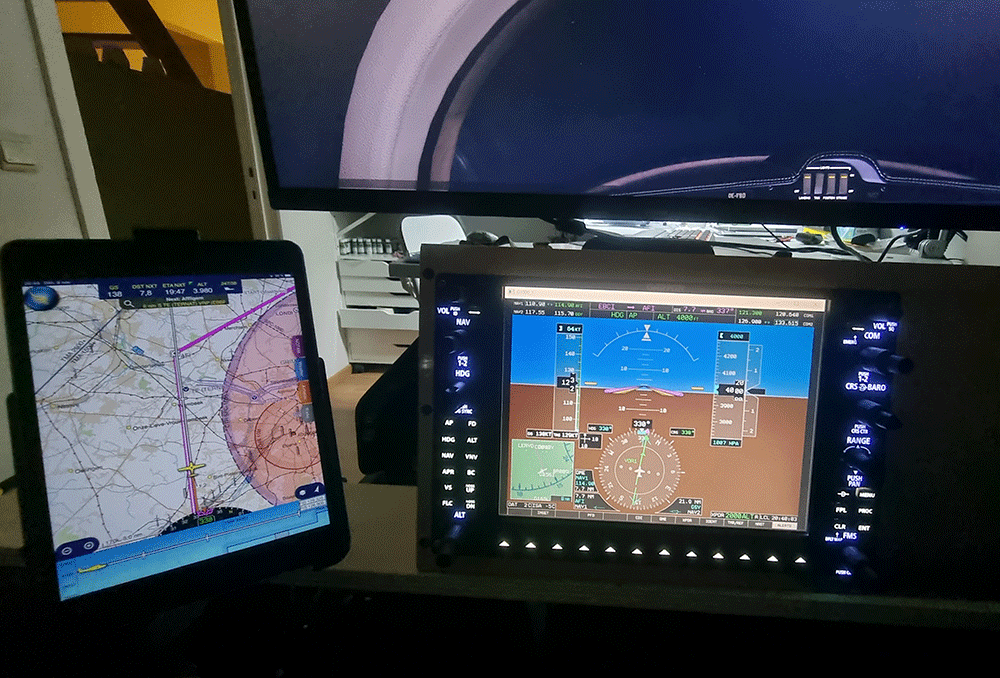
The day of the flight was set mid December 2022, the afternoon was spent to plan for the navigation flight. Fuel, navigation , notam, weather, extra batteries for the frontal red/white light, load sheet. everything up to the last possible bit. Then I had a very late lunch and took the 90 minutes drive to the airport.
The weather was clear with very light winds from the North, moon was up and temperature was -6°C on the ramp.
When arriving at the airport the aircraft was covered with frost. Not only this would be my first night navigation, it was also going to be my first time de-icing an airplane.
After all, flying is an adventure.
We started engine at 1940 local and after our checks and entering the flight plan in the G1000 we taxied to the active runway carefully following the colour coded taxi lights. We decided NOT to use the autopilot and I would hand fly the aircraft tracking the relevant radials.
We took off and turned North to the CTR exit point. ATC assigned us FL70 for the flight so we kept climbing and I added another first to this flight: although it wouldn’t be the first time I would set QNE, It would be my highest flight beating my last record of FL60.
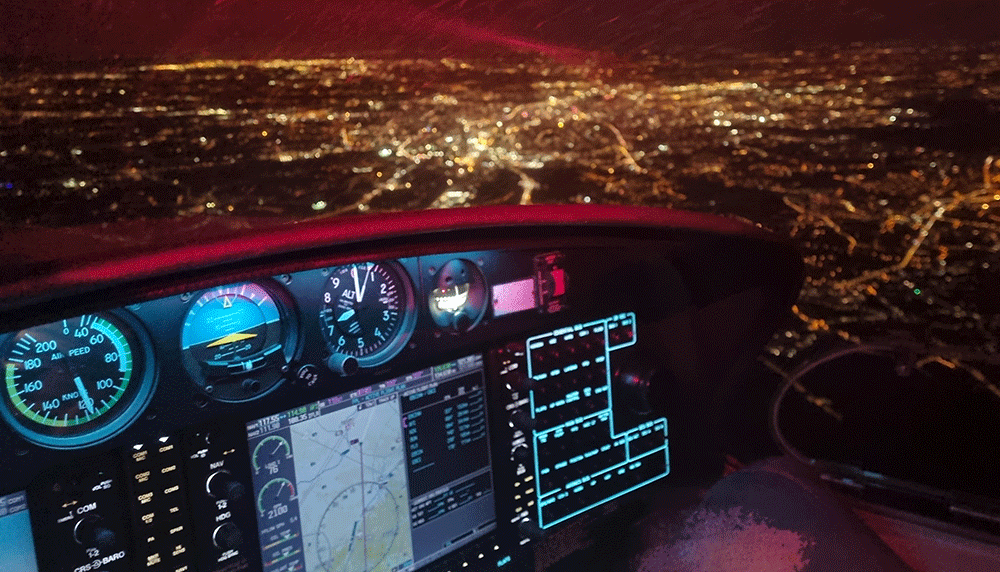
I didn’t have much trouble tracking the radials. the night was calm, ATC was relatively quiet and the flight progressed with no issue at all. On the second part of the flight, We had more traffic as we crossed above the ILS of EBBR RWY 25. I felt it was easier to spot traffic at night than during an usual day VFR flight.
On the last leg of the flight we asked ATC to setup an ILS 24 for our recovery at EBCI. They kindly cooperated and handed us off to Charleroi approach who asked us to maintain our speed to the last possible moment. Once again the approach was done in the cockpit for me and outside for my Instructor.
After that flight I couldn’t sleep for a long while as I was so hyped up.
Wrapping up:
The third flight was uneventful, more touch and goes done in January 2023. More traffic and I learned how to avoid wake turbulence on landing ensuring proper separation. The landing light of the DA-40 is not getting any better 🙂
My last flight was done early February. I missed 1 hour flight time and 5 solo take-offs and landings.
My usual aircraft was close to her hour limit, so I had to reschedule to a regular Da-40 (non G1000) but for touch and goes the G1000 is overrated (and more expensive) so I welcomed the change.
I arrived at the airport at 5.30pm local and it was still daylight. Looks like Spring was coming fast. Night started at 6.17pm local so we had plenty of time to pre-flight and assist to a student solo before starting the engine.
We made one touch and go and then one full stop where my instructor got out of the plane, gave me a thumbs up.
Light winds, snow moon and very light traffic at the airport. Off I was flying on my own at night. My instructor identified a few of my weak points during the previous flight and I worked hard to have these perfected flying solo. 5 landings later I made my full stop and taxied back to the parking.
Conclusions:
It was a great experience and I cannot recommend it enough.
I learned a lot of new things after flying on my own for a couple of years.
It was challenging and today as a low hour VFR pilot I feel more confident in my abilities thanks to that experience.
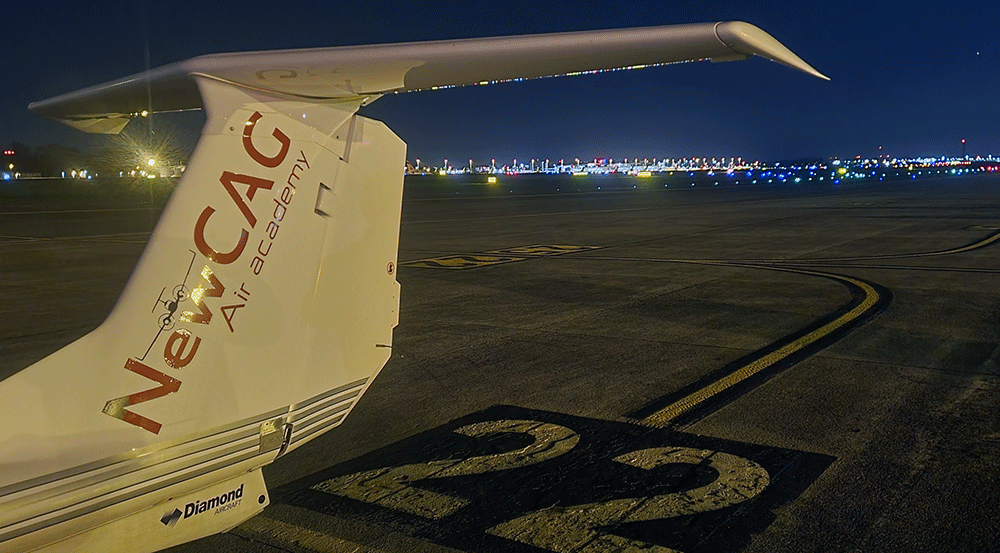
Total cost for the Night rating was 1720 euros for the 6.27 flight time hours (1h sim) and the ground briefing. Adding the rating to my licence took another 120 euros paid to the BCAA. It is expensive but I would have anyway (day solo in the Da-20 from EBGB) to maintain proficiency so it is not that bad. And the joy, excitement and experience I got out of it is priceless.
Pilots need to keep learning and the night VFR is a great way to meet new challenges.
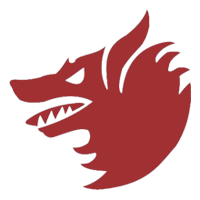
Hey, RedDog!
Didn’t know about your real-life experiences until today – congratulations on your rating and thanks for a really nice read! 🙂
Thanks Michi.
I guess we can say simulation leads to real flying. It’s obviously the case here 🙂
thanks for visiting 🙂